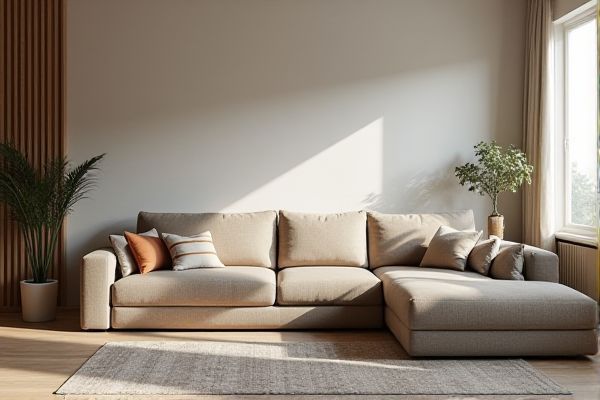
Sectionals offer customizable seating arrangements ideal for maximizing space and comfort in larger rooms, while sofas provide a classic, versatile option suited for smaller areas or more minimalistic setups. Discover which choice best fits Your living space and lifestyle by exploring the detailed comparisons ahead.
Table of Comparison
| Feature | Sectional Sofa | Sofa |
|---|---|---|
| Design | Modular, multiple connected pieces | Single-piece seating |
| Seating Capacity | Usually 4-6+ people | Typically 2-4 people |
| Space Utilization | Fits large and corner spaces well | Best for smaller, open spaces |
| Customization | Highly customizable arrangement | Limited customization options |
| Comfort | Supports lounging and reclining | Standard sitting comfort |
| Cost | Usually higher price due to size | Generally more affordable |
| Portability | Harder to move and rearrange | Easier to move and reposition |
| Style Versatility | Modern and casual styles | Varied styles from traditional to contemporary |
Introduction: Sectional vs Sofa
Sectional sofas provide versatile seating arrangements with modular pieces that can be customized to fit your living space, while traditional sofas offer a compact, classic design ideal for smaller areas. Sectionals often include features like recliners or chaise lounges, enhancing comfort and functionality beyond standard sofas. Choosing between a sectional and a sofa depends on your room size, seating needs, and style preferences to create the perfect balance of space and comfort.
Defining Sectionals and Sofas
Sectionals are modular seating units composed of multiple sections that can be arranged in various configurations to fit your living space, offering flexibility and customization. Sofas, typically one continuous piece, provide a classic, uniform seating option designed for comfort and style. Understanding these key differences helps you choose between a versatile sectional or a traditional sofa that best suits your room layout and lifestyle.
Design and Style Differences
Sectionals offer a versatile design with multiple connected seating units that can be arranged to fit large spaces or create cozy corners, featuring modular configurations for customized style. Sofas typically present a single, unified piece with a classic, streamlined silhouette ideal for traditional or minimalist interiors. Sectionals often emphasize contemporary, dynamic aesthetics while sofas lend themselves to timeless, elegant looks.
Space and Room Layout Considerations
Sectionals offer flexibility for larger rooms, as they can be arranged to fit corners and maximize seating while defining open spaces. Sofas suit smaller spaces better, requiring less floor area and allowing for easier movement around the room. When planning room layout, consider sectional dimensions for optimal flow and use sofa placement to maintain an airy, uncluttered environment.
Comfort and Seating Capacity
Sectionals offer superior seating capacity and flexibility, accommodating multiple people comfortably with their modular design ideal for larger living spaces. Sofas provide a cozier seating option, with limited capacity suitable for smaller rooms or intimate settings. Comfort in sectionals typically comes from their spacious layout and customizable configurations, while sofas emphasize plush cushioning and style for individual or couple use.
Customization and Configurability
Sectionals offer extensive customization and configurability options, allowing you to choose modular pieces that fit specific room layouts and personal style preferences. Sofas typically come as one fixed piece, limiting adjustments but providing a consistent shape and design. Your choice depends on whether you prioritize flexibility and adaptability or a classic, streamlined look.
Material and Durability Comparison
Sectionals typically use high-density foam cushions and hardwood frames, offering superior durability and support compared to traditional sofas, which often feature lower-density foam and less robust framing materials. Leather and performance fabrics used in sectionals resist wear and stains better than the less durable upholstery fabrics common in many sofas. The modular design of sectionals also allows for easier maintenance and replacement of individual sections, enhancing their longevity relative to standard sofa designs.
Cost and Budget Implications
Sectional sofas often have higher upfront costs due to their larger size and customizable configurations, making them a significant investment for spacious living areas. Sofas generally come with a lower price range, offering budget-friendly options suitable for smaller spaces or tighter budgets. Considering delivery and potential reconfiguration fees can also impact the total cost when choosing between sectionals and traditional sofas.
Maintenance and Cleaning Tips
Sectional sofas with modular cushions require regular vacuuming and spot cleaning to prevent dirt buildup in seams, while traditional sofas benefit from frequent fabric brushing and occasional professional deep cleaning to maintain upholstery integrity. Using fabric protectors and choosing machine-washable cushion covers can simplify maintenance for both sofa types. Promptly addressing spills with appropriate cleaning agents tailored to the material--leather, microfiber, or fabric--extends furniture lifespan and preserves appearance.
Choosing the Right Option for Your Home
Sectionals offer versatile seating configurations ideal for larger living spaces or families seeking ample seating, while sofas suit smaller rooms with their streamlined design and easier placement options. When choosing the right option for your home, consider room size, seating needs, and lifestyle, as sectionals maximize space efficiency and social interaction, whereas sofas provide a classic look and easier mobility. Assess fabric durability, style compatibility, and budget to ensure your furniture complements your home's function and aesthetic.
 homyna.com
homyna.com